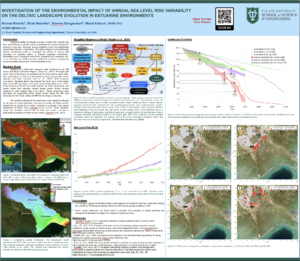2025 CSDMS meeting-036: Difference between revisions
From CSDMS
Created page with "{{CSDMS meeting personal information template-2025 |CSDMS meeting first name=Ahmed |CSDMS meeting last name=Khalifa |CSDMS Pronouns=He/His |CSDMS meeting institute=Tulane University |CSDMS meeting city=New Orleans |CSDMS meeting country=United States |CSDMS meeting state=Louisiana |CSDMS meeting email address=akhalifa1@tulane.edu |CSDMS meeting phone=5044085824 }} {{CSDMS meeting select clinics1 2025 |CSDMS_meeting_select_clinics1_2025=1) Coupled Simulations in ASPECT/Fa..." |
No edit summary |
||
| (2 intermediate revisions by the same user not shown) | |||
| Line 31: | Line 31: | ||
{{CSDMS meeting abstract template 2025 | {{CSDMS meeting abstract template 2025 | ||
|CSDMS meeting abstract=Traditional deltaic landscape evolution models often simplify sea level rise (SLR) as a smooth curve to represent the impact of long-term increase in sea level. However, annual variability in SLR can significantly impact these dynamic ecosystems. This study employs a computationally efficient biophysical model to investigate the effects of varying SLR scenarios on Barataria Basin, a complex estuarine environment. Simulations were conducted using three smoothed SLR estimates (2m, 1.1m, and 0.6m by 2100) and four additional scenarios incorporating annual variability around each of the smoothed curves. Our findings suggest that Barataria Basin could experience substantial land loss, potentially ranging from 50,000 to 70,000 acres between 2030 and 2070 due to annual variability in SLR. These results underscore the critical need to consider SLR variability in coastal planning and management strategies to mitigate the impacts of rising sea levels. | |CSDMS meeting abstract=Traditional deltaic landscape evolution models often simplify sea level rise (SLR) as a smooth curve to represent the impact of long-term increase in sea level. However, annual variability in SLR can significantly impact these dynamic ecosystems. This study employs a computationally efficient biophysical model to investigate the effects of varying SLR scenarios on Barataria Basin, a complex estuarine environment. Simulations were conducted using three smoothed SLR estimates (2m, 1.1m, and 0.6m by 2100) and four additional scenarios incorporating annual variability around each of the smoothed curves. Our findings suggest that Barataria Basin could experience substantial land loss, potentially ranging from 50,000 to 70,000 acres between 2030 and 2070 due to annual variability in SLR. These results underscore the critical need to consider SLR variability in coastal planning and management strategies to mitigate the impacts of rising sea levels. | ||
|CSDMS meeting posterPDF= Poster-Ahmed_Khalifa-CSDMS-2025.pdf | |||
|CSDMS meeting posterPNG= Poster-Ahmed_Khalifa-CSDMS-2025.png | |||
|CSDMS meeting | |||
}} | }} | ||
{{blank line template}} | {{blank line template}} | ||
Latest revision as of 08:16, 17 February 2025
(if you haven't already)
Log in (or create account for non-CSDMS members)
Forgot username? Search or email:CSDMSweb@colorado.edu
Browse abstracts
Investigation of the environmental impact of annual sea level rise variability on the deltaic landscape evolution in estuarine environments
Ahmed Khalifa,
(He/His),Tulane University New Orleans Louisiana, United States. akhalifa1@tulane.edu
Traditional deltaic landscape evolution models often simplify sea level rise (SLR) as a smooth curve to represent the impact of long-term increase in sea level. However, annual variability in SLR can significantly impact these dynamic ecosystems. This study employs a computationally efficient biophysical model to investigate the effects of varying SLR scenarios on Barataria Basin, a complex estuarine environment. Simulations were conducted using three smoothed SLR estimates (2m, 1.1m, and 0.6m by 2100) and four additional scenarios incorporating annual variability around each of the smoothed curves. Our findings suggest that Barataria Basin could experience substantial land loss, potentially ranging from 50,000 to 70,000 acres between 2030 and 2070 due to annual variability in SLR. These results underscore the critical need to consider SLR variability in coastal planning and management strategies to mitigate the impacts of rising sea levels.

